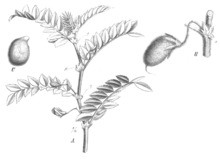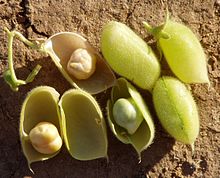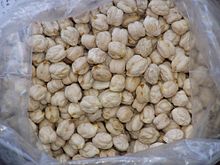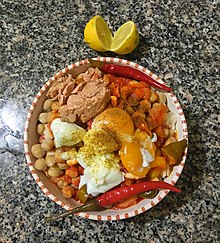chick-pea
| chick-pea | ||||||||||||
|---|---|---|---|---|---|---|---|---|---|---|---|---|

Chickpea ( Cicer arietinum ) |
||||||||||||
| Systematics | ||||||||||||
|
||||||||||||
| Scientific name | ||||||||||||
| Cicer arietinum | ||||||||||||
| L. |
The chickpea ( Cicer arietinum ), whether real giggle , Roman Kicher , Venus chick peas or field peas called, is a plant from the kind of chick peas ( Cicer ) in the subfamily of the Pea family (Faboideae) within the family of legumes (Fabaceae). It is not closely related to the pea ( Pisum sativum ). It is an old crop .
description

Vegetative characteristics
The chickpea is an annual herbaceous plant that reaches heights of up to 1 meter. The angular and glandular-haired stems are upright to lying and more or less branched. The plant has a deep taproot .
The alternate, stalked, about 4–8 cm long, short leaves are unpinnate. The 7 to 17 at the edge, in the front part, serrated, egg-shaped to elliptical or obovate and pointed leaflets are about 7 to 18 mm in size. They are almost sitting or sitting on a runny rachis . The whole leaves are hairy glands. The two to five-part stipules with unequal tips are hairy glands.
Generative characteristics
On a longer stem, usually singly or in pairs, the flowers are in the leaf axils. The hermaphrodite flowers are zygomorphic and five-fold, and 10 to 12 mm in size with a double flower envelope . The flower stalks and the calyx are hairy glands. The flowers are on the glandular, long inflorescence stalk of the greatly reduced inflorescence and there are small bracts . The eilanzettlichen, green calyx lobes are pointed. The five white to white-purple or reddish to violet or bluish petals stand together in the typical shape of the butterfly flowers.
The roughly 2.5–3.5 cm short, somewhat puffed and glandular, greenish, tipped legumes usually contain one to two (four) seeds. The irregularly shaped, but rounded to egg-shaped, about 5-15 millimeters in size, smooth, more or less wrinkled seeds are beige to brown and green to black in color. The seeds or cotyledons can be eaten. The thousand grain mass is between 200 and over 600 grams, normal are around 300–500 grams. The seeds of chickpea can easily allow the Lathyrus sativus ( Lathyrus sativus be confused).
The number of chromosomes is 2n = 14, 16 or 32.
Systematics
The first publication of Cicer arietinum was in 1753 by Carl von Linné in Species Plantarum , 2, p. 738. The specific epithet arietinum means "ram-like" and was supposedly chosen because the seed should resemble a ram's head. Synonyms for Cicer arietinum L. are: Cicer album hort., Cicer arientinium L. , Cicer arientinum L. , Cicer edessanum Bornm. , Cicer grossum Salisb. , Cicer nigrum hort., Cicer physodes Rchb. , Cicer rotundum Aleph. , Cicer sativum Schkuhr , Cicer sintenisii Bornm. , Ononis crotalarioides M.E. Jones .
Cicer arietinum belongs to the Cicer series from the Cicer section in the subgenus Cicer within the genus chickpeas .
Occurrence
Chickpeas are grown in many subtropical areas of the world. India and Australia are world leaders in manufacturing.
Chickpea varieties make little demands on the soil and get by with little water . In the temperate climate zones , the yields are low due to the lack of heat.
history
The chickpea probably comes from the wild growing Cicer reticulatum Lad. 8000 year old finds of cultivated chickpeas attest to their cultivation in the Neolithic period in Asia Minor . The chickpea was spread from there to the Near East , the Mediterranean and India. In Greece , pulses have been part of the diet since the Copper Age. In Asia Minor, chickpeas have been found in Karmir Blur , Yoncatepe, and Bastam . Chickpeas are also known from Troy VIIb and Gordion .
The chickpea has been cultivated as a useful crop in Greece and Italy since ancient times. In Germany, the only seeds found come from Roman times. In the estate regulations of Charlemagne , the chickpea is listed as 'cicerum italicum' in chapter 70. Hildegard von Bingen recommended Kicher as a light and pleasant food and as a remedy for fever. Albertus Magnus distinguished three varieties: white, red and black or dark form. Hieronymus Bock mentioned the Zysern (term in herbal books of the 16th century for giggles: Ziser or Zisererbsen) not for use in the kitchen, but rather as a medicine. After the First World War , roasted dark-seeded chickpeas were used as a coffee substitute in the vineyards on the Rhine and in Württemberg .
Historical forms of culture:
- Cicer arietinum fo. album with yellowish white seeds as food
- Cicer arietinum fo. fuscum with red-brown seeds
- Cicer arietinum fo. macrospermum with large, black seeds as a coffee substitute
- Cicer arietinum fo. vulgare with black seeds: for animal feed
use
The chickpea is mainly grown for human nutrition . The main growing areas of the chickpea today are Turkey , North Africa , Mexico , Afghanistan , India , Australia , Pakistan and Spain . In Mexico and India, chickpeas are still an important staple food. There are two types of food that are used in the kitchen: the small, wrinkled seeds from India and the larger, round, beige-yellow seeds from the Mediterranean, which are better known and more widespread in Europe.
They can be bought ready-cooked in cans or as dried seeds (similar to green peas). The dried seeds are soaked cold (12 to 24 hours and longer) and then prepared as a stew , broth or puree, for example . In the Middle East and North Africa, among other things, chickpeas are roasted and eaten like nuts. The falafel, which is widespread in the Middle East and North Africa, is also made from seasoned chickpea pulp . In oriental cuisine, a paste made from chickpeas and sesame , called Hommos we Tahini or just hummus (spelling varies in the Latin alphabet), is very popular. Another preparation made from chickpea flour is the Italian farinata , also known as socca in the French city of Nice . In addition, dishes with chickpeas ( garbanzos there ) are known in Spain , for example cocido madrileño is a cooked national dish . In the Orient , a pastry made from fermented seeds is known as Schimitt . In Turkey, twice roasted seeds are known as leblebi , which are eaten like nuts, and a stew with meat is also common across the country. In Provence , a pastry is made from a mixture of chickpea and wheat flour . In India, young chickpea plants are used to prepare a salad or the cooked chickpeas are consumed under the name Chana Masala . In Tunisia , lablabi , which is made from chickpeas, tuna, harissa and eggs, is one of the national dishes .
Chickpea flour is also used in Indian cuisine, in the batter for pakora , in the sweet balls called Laddu , which are offered to the god Ganesha , among other things , and in various side dishes and biscuits. It is very rich in protein and, unlike wheat flour, gluten-free. It is also used with yogurt as an exfoliant. Chickpea flour pancakes are also known as farinata in Italy , particularly Liguria , and tortillitas de camarones in Andalusia, along with shrimp .
Average composition
The composition of chickpeas naturally fluctuates, both depending on the variety, the environmental conditions such as soil and climate, and the cultivation technique depending on fertilization and plant protection.
Details per 100 grams of dried chickpeas:
|
|
|
|
The physiological calorific value is 1294 kJ (306 kcal) per 100 grams of edible portion. The high content of the amino acids arginine, leucine and lysine is striking.
Raw "chickpeas" - correctly would be "chickpea seeds" - contain the indigestible toxin phasin , which is broken down by the action of heat. Chickpeas should therefore only be eaten well cooked. The chickpea also uses raffinose as a storage carbohydrate, albeit only in relatively small amounts of 290 mg per 100 g dry weight. This triple sugar cannot be metabolized directly by humans and thus reaches the large intestine, where it is broken down under the influence of intestinal bacteria and gas is formed. Raffinose is to be regarded as dietary fiber .
Economical meaning
In 2018, India was the main producer of chickpeas with 66.2% of the world harvest. The 10 largest producers could bring in 94.3% of the harvest.
| rank | country | Quantity (in t ) |
|---|---|---|
| 1 |
|
11,380,000 |
| 2 |
|
998.231 |
| 3 |
|
630,000 |
| 4th |
|
620,400 |
| 5 |
|
577.970 |
| 6th |
|
515,642 |
| 7th |
|
509.856 |
| 8th |
|
351,796 |
| 9 |
|
323.364 |
| 10 |
|
323.364 |
| world | 17.192.188 |
Diseases
The most important pests in chickpea cultivation are Fusarium oxysporum , which causes Fusarium wilt , and Didymella rabiei ( Syn .: Ascochyta rabiei ). In some countries such as Mexico, Italy and Australia, the chickpea rust ( Uromyces ciceris-arietini ) is also important.
Origin of words and common names
The Latin name of the plant is cicer - possibly related to the Hebrew kikar (round, rounded). Because the Latin "C" is spoken of as "K" (ie, "Kiker") was then finally in the resulting MHG and NHG Kicher , ie to denote the chickpea seeds of Cicer arietinum .
The other German-language trivial names exist or existed for the chickpea : Chicher, Chicherri, Chichirra, Chichuria, Chichurra, Cicererbis, Cisa, Cyfer, Czycke, Kichern (Old High German), Garabanzen ( Mark Brandenburg ), Kecher, Kechern, Kechir, Keichern, Kicherkraut , Kircheren, Kirchernkraut, Kyechirn, Seker, Sekeren, Ziseren, Schwarz Zisern, Ziser-Erwedsen, Zysern and Zyssern (Middle High German), Keicheren, Kekeren, Keyker ( Middle Low German ), Kicher ( Saxony ), Sisern, Sperberköpfl ( Styria ).
See also
Web links
- Cicer arietinum at PROTA.
- Cicer arientum at Feedipedia.
- Cicer arietinum L., chickpea. In: FloraWeb.de.
- Distribution map for Germany. In: Floraweb .
- Cicer arietinum L. In: Info Flora , the national data and information center for Swiss flora . Retrieved November 21, 2015.
Individual evidence
- ^ Erich Oberdorfer : Plant-sociological excursion flora for Germany and neighboring areas. 8th edition. Verlag Eugen Ulmer, Stuttgart 2001, ISBN 3-8001-3131-5 , p. 607.
- ^ First publication by Linné in 1753, scanned at biodiversitylibrary.org .
- ↑ a b Helmut Genaust: Etymological dictionary of botanical plant names. 3rd, completely revised and expanded edition. Birkhäuser, Basel / Boston / Berlin 1996, ISBN 3-7643-2390-6 , pp. 12, 75, 155.
- ↑ Data sheet at International Legume Database Information Service = ILDIS - LegumeWeb - World Database of Legumes , Version 10.38 from July 20, 2010.
- ^ Cicer arietinum at Tropicos.org. Missouri Botanical Garden, St. Louis, accessed July 17, 2013.
- ^ Cicer arietinum in the Germplasm Resources Information Network (GRIN), USDA , ARS , National Genetic Resources Program. National Germplasm Resources Laboratory, Beltsville, Maryland. Retrieved July 17, 2013.
- ↑ a b Crops. In: FAO production statistics 2020. fao.org, accessed on March 23, 2020 (English).
- ↑ Emel Oybak Dönmez, Oktay Belli: Urartian Plant Cultivation at Yoncatepe (Van), Eastern Turkey. In: Economic Botany. Volume 61, No. 3, p. 296.
- ↑ Udelgard Körber-Grohne : Useful plants in Germany from prehistory to today. Nikol Verlagsgesellschaft GmbH, Hamburg 1995, ISBN 3-933203-40-6 , pp. 361-363.
- ↑ J. Becker-Dillingen : Handbook of the legume cultivation and forage cultivation. Parey, 1929.
- ↑ German Research Institute for Food Chemistry , Garching (ed.): Food table for practice . 4th edition. Wissenschaftliche Verlagsgesellschaft mbH, Stuttgart 2009, ISBN 978-3-8047-2541-6 , p. 323 .
- ↑ Percentage of raffinose in various foods at Eucell.
- ↑ T. Millan, HJ Clarke, KHM Siddique, HK Buhariwalla, PM Gaur, J. Kumar, J. Gil, G. Kahl, P. Winter: Chickpea molecular breeding: new tools and concepts. In: Euphytica. Volume 147, 2006, pp. 81-103.
- ^ MV Reddy, HE Gridley, HJ Kaack: Major disease problems of chickpea in North Africa. In: Int. Chickpea Newsl. Volume 3, 1980, pp. 13-14.
- ↑ Josefina C. Sillero, Inmaculada Moreno-Alías, Diego Rubiales: Identification and characterization of resistance to rust (Uromyces ciceris-arietini (Grognot) Jacz. & Boyd) in a germplasm collection of Cicer spp. In: Euphytica. Volume 188, Issue 2, 2012, pp. 229-238, doi: 10.1007 / s10681-012-0709-x .
- ^ Rudolf Schubert and Günther Wagner: Plant names and botanical terms. Botanical lexicon with an introduction to terminology and nomenclature, a list of the authors' names and an overview of the plant system. 6th edition. Melsungen, Berlin, Basel and Vienna 1975, p. 106.
- ^ Georg August Pritzel , Carl Jessen : The German folk names of plants. New contribution to the German linguistic treasure. Philipp Cohen, Hannover 1882, p. 97 f, archive.org .








